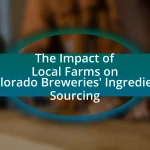The main entity of the article is Colorado’s barley, which plays a crucial role in the state’s brewing industry. The article outlines the journey of barley from local farms, primarily in the San Luis Valley and Arkansas Valley, to breweries across Colorado. It details the cultivation process, including soil preparation, irrigation management, and harvesting techniques, as well as the subsequent steps of drying, malting, and transportation to breweries. Additionally, the article highlights the significance of Colorado’s barley in supporting local agriculture, contributing to the economy, and fostering a vibrant craft beer culture, while also discussing sustainable farming practices and the cultural importance of barley in brewing events and festivals.
What is the journey of Colorado’s barley from farm to brewery?
Colorado’s barley journey begins on local farms where it is cultivated, primarily in the San Luis Valley and the Arkansas Valley, known for their ideal growing conditions. After harvesting, the barley is transported to malting facilities, where it undergoes a process of soaking, germination, and drying to convert starches into fermentable sugars. This malted barley is then sent to breweries across Colorado, where it is used as a key ingredient in beer production. The entire process supports local agriculture and contributes to the state’s vibrant craft beer industry, with over 400 breweries utilizing Colorado-grown barley.
How is barley cultivated in Colorado?
Barley is cultivated in Colorado primarily through a process that involves selecting suitable varieties, preparing the soil, planting, managing irrigation, and harvesting. Farmers in Colorado typically choose varieties like ‘Harrington’ and ‘Conlon’ that are well-suited to the state’s climate and soil conditions.
Soil preparation includes tilling and ensuring proper pH levels, which are crucial for barley growth. Planting usually occurs in the spring, with seeds sown at a depth of 1 to 2 inches. Irrigation management is essential due to Colorado’s semi-arid climate, often utilizing both surface and drip irrigation methods to ensure adequate moisture.
Harvesting typically takes place in late summer when the grains reach physiological maturity, indicated by a change in color and moisture content. According to the Colorado Department of Agriculture, barley is a significant crop in the state, contributing to both local agriculture and the brewing industry, with over 60,000 acres dedicated to barley production annually.
What are the key growing conditions for barley in Colorado?
The key growing conditions for barley in Colorado include well-drained soils, adequate sunlight, and a specific climate that supports its growth. Barley thrives in loamy or sandy soils with a pH between 6.0 and 7.5, which allows for optimal nutrient uptake. The state experiences a semi-arid climate with average annual precipitation of 12 to 20 inches, making irrigation essential during dry spells. Additionally, barley requires a growing season of about 90 to 120 days, with temperatures ideally ranging from 60°F to 75°F during the day. These conditions contribute to the successful cultivation of barley, which is vital for Colorado’s brewing industry.
Which barley varieties are most commonly grown in Colorado?
The most commonly grown barley varieties in Colorado are Colorado State University (CSU) varieties, specifically ‘Harrington’ and ‘Conlon’. Harrington is known for its high yield and disease resistance, while Conlon is favored for its malting quality. These varieties are supported by Colorado’s climate and soil conditions, which are conducive to barley production, making them popular choices among local farmers.
What processes are involved in harvesting and processing barley?
The processes involved in harvesting and processing barley include cutting, threshing, drying, and malting. Harvesting begins with cutting the barley plants using a combine harvester, which simultaneously cuts and threshes the grain from the chaff. After cutting, the barley is dried to reduce moisture content, typically to around 12-14%, which is essential for storage and prevents spoilage. Following drying, the barley undergoes malting, where it is soaked in water, allowed to germinate, and then dried again to develop enzymes necessary for brewing. This sequence of steps ensures that the barley is properly prepared for its final use in breweries, where it contributes to the production of beer.
How is barley harvested in Colorado?
Barley in Colorado is harvested using specialized machinery known as combines, which efficiently cut, thresh, and clean the grain in one operation. The harvest typically occurs in late summer to early fall when the barley reaches optimal maturity, indicated by a golden-brown color and low moisture content. According to the Colorado Department of Agriculture, the state produces around 100,000 acres of barley annually, making it a significant crop for both local breweries and the agricultural economy.
What steps are taken to process barley after harvesting?
After harvesting, barley undergoes several key processing steps: drying, cleaning, and malting. Initially, harvested barley is dried to reduce moisture content, typically to around 12-14%, which prevents spoilage and prepares it for storage. Following drying, the barley is cleaned to remove impurities such as dirt, stones, and other grains, ensuring a high-quality product. The final step is malting, where the cleaned barley is soaked in water, allowed to germinate, and then dried again. This process activates enzymes that convert starches into fermentable sugars, essential for brewing. These steps are critical for transforming raw barley into a suitable ingredient for beer production, aligning with industry standards for quality and safety.
Why is Colorado’s barley significant to the brewing industry?
Colorado’s barley is significant to the brewing industry because it provides high-quality ingredients essential for producing a diverse range of beers. The state’s unique climate and soil conditions contribute to the cultivation of barley varieties that are particularly suited for brewing, such as two-row and six-row barley. According to the Colorado State University Extension, Colorado ranks among the top barley-producing states in the U.S., with over 70% of its barley used for malting, which is crucial for beer production. This local supply chain supports both craft and large-scale breweries, enhancing the state’s reputation as a brewing hub.
How does Colorado’s climate influence barley quality?
Colorado’s climate significantly influences barley quality through its unique combination of altitude, temperature, and precipitation patterns. The state’s high elevation, averaging around 6,800 feet, results in cooler temperatures that extend the growing season, allowing barley to develop complex flavors and higher sugar content. Additionally, Colorado experiences low humidity and ample sunlight, which contribute to the barley’s disease resistance and overall health. Research indicates that these climatic conditions lead to barley with superior malting qualities, essential for brewing, as evidenced by Colorado being one of the top barley-producing states in the U.S.
What role does Colorado barley play in local breweries?
Colorado barley serves as a crucial ingredient in local breweries, providing the primary source of fermentable sugars necessary for beer production. This barley is often grown in the state’s fertile agricultural regions, where the climate and soil conditions are ideal for high-quality grain cultivation. The use of locally sourced barley not only enhances the flavor profile of the beer but also supports the local economy by fostering relationships between farmers and brewers. In 2021, Colorado produced over 1.5 million bushels of barley, underscoring its significance in the brewing industry.

How does barley transition from farm to brewery?
Barley transitions from farm to brewery through a series of steps that include harvesting, drying, malting, and brewing. After barley is harvested from farms, it is dried to reduce moisture content, which prevents spoilage. The dried barley is then sent to malting facilities where it undergoes soaking, germination, and kilning to convert starches into fermentable sugars. This malted barley is subsequently transported to breweries, where it is mashed, boiled, and fermented to produce beer. The entire process is essential for ensuring that the barley retains its quality and flavor, which is crucial for brewing.
What logistics are involved in transporting barley to breweries?
Transporting barley to breweries involves several logistics, including sourcing, storage, transportation, and delivery. First, barley is harvested from farms and then stored in silos or warehouses to maintain quality. Next, transportation logistics are coordinated, typically involving trucks or rail systems to move the barley from storage facilities to breweries. The delivery process must consider factors such as timing, temperature control, and route optimization to ensure the barley arrives fresh and in good condition. Efficient logistics management is crucial, as breweries often require specific barley varieties for brewing, necessitating precise tracking and scheduling to meet production timelines.
How are transportation methods chosen for barley delivery?
Transportation methods for barley delivery are chosen based on factors such as distance, cost, and the condition of the barley. For instance, shorter distances may utilize trucks for their flexibility and speed, while longer distances might favor rail transport due to its cost-effectiveness for bulk shipments. Additionally, the quality of barley is a critical consideration; methods that minimize handling and exposure to elements are preferred to maintain grain integrity. According to the Colorado Department of Agriculture, efficient logistics are essential for ensuring that barley reaches breweries in optimal condition, highlighting the importance of selecting appropriate transportation methods.
What challenges are faced during the transportation of barley?
Transportation of barley faces several challenges, including logistical issues, weather conditions, and regulatory compliance. Logistical issues arise from the need to coordinate between farms, storage facilities, and breweries, which can lead to delays and increased costs. Weather conditions, such as heavy rain or snow, can disrupt transport routes and damage the barley, affecting its quality. Regulatory compliance involves adhering to local and federal regulations regarding food safety and transportation, which can complicate the shipping process. These challenges can impact the overall efficiency and cost-effectiveness of barley transportation from farms to breweries.
What processes do breweries use to incorporate barley into beer production?
Breweries incorporate barley into beer production through several key processes: malting, mashing, boiling, and fermentation. During malting, barley grains are soaked in water, allowed to germinate, and then dried in a kiln, converting starches into fermentable sugars. In the mashing process, the malted barley is mixed with hot water, activating enzymes that further break down the starches into sugars. This mixture, known as wort, is then boiled with hops to add bitterness and aroma. Finally, yeast is added during fermentation, where it consumes the sugars from the wort, producing alcohol and carbonation. These processes are essential for transforming barley into the final beer product, ensuring the desired flavor and quality.
How is barley malted before brewing?
Barley is malted before brewing through a process that involves soaking, germinating, and drying the grains. Initially, barley grains are soaked in water for 24 to 48 hours, allowing them to absorb moisture and begin the germination process. During germination, which lasts about 4 to 6 days, enzymes are activated that convert starches into fermentable sugars. After germination, the grains are dried in a kiln to halt the process, resulting in malted barley. This malt is then ground into a powder, known as grist, which is used in the brewing process. The malting process is crucial as it develops the flavors and sugars necessary for fermentation, making it a foundational step in beer production.
What are the different brewing techniques that utilize barley?
The different brewing techniques that utilize barley include mashing, boiling, fermentation, and conditioning. Mashing involves soaking crushed barley malt in hot water to convert starches into fermentable sugars, which is essential for producing alcohol. Boiling follows mashing, where the wort is heated and hops are added for flavor and aroma. Fermentation occurs when yeast is introduced to the cooled wort, converting sugars into alcohol and carbon dioxide. Finally, conditioning allows the beer to mature, enhancing its flavors and carbonation. Each of these techniques is crucial in the brewing process, with barley serving as the primary source of fermentable sugars.
What are the impacts of Colorado’s barley on the local economy and culture?
Colorado’s barley significantly impacts the local economy and culture by supporting the state’s brewing industry and agricultural sector. The barley production in Colorado contributes approximately $200 million annually to the state’s economy, with over 60% of the barley grown being used for brewing purposes. This strong connection between barley farming and local breweries fosters a vibrant craft beer culture, with Colorado being home to more than 400 breweries, which collectively employ thousands of residents and attract tourism. Additionally, local barley cultivators often engage in sustainable farming practices, enhancing community ties and promoting local food systems. The cultural significance of barley is further reflected in events like the Colorado Brewers’ Festival, celebrating the state’s brewing heritage and the role of barley in it.
How does barley farming contribute to Colorado’s agricultural economy?
Barley farming significantly contributes to Colorado’s agricultural economy by providing a vital crop for both local consumption and export. In 2021, Colorado produced approximately 1.5 million bushels of barley, which supports the state’s brewing industry, a major economic driver. The state’s barley is primarily used for malt production, with over 400 breweries relying on locally sourced barley, thereby creating jobs and stimulating economic activity. Additionally, barley farming enhances soil health and promotes sustainable agricultural practices, further solidifying its role in Colorado’s agricultural landscape.
What economic benefits do local farmers gain from barley production?
Local farmers gain several economic benefits from barley production, including increased income, job creation, and market stability. Barley serves as a cash crop, providing farmers with a reliable source of revenue; for instance, in Colorado, barley production contributes approximately $100 million annually to the state’s economy. Additionally, barley farming supports local jobs in agriculture and related industries, enhancing community employment opportunities. Furthermore, the demand for barley from breweries fosters market stability, as breweries often establish long-term contracts with farmers, ensuring consistent sales and reducing market volatility.
How does barley production support local jobs and communities?
Barley production supports local jobs and communities by creating employment opportunities in agriculture, processing, and distribution sectors. In Colorado, barley farming employs numerous individuals, from farmers to laborers, contributing to the local economy. Additionally, the barley industry stimulates job creation in breweries and related businesses, which rely on locally sourced barley. According to the Colorado Department of Agriculture, the state’s barley industry generates over $100 million annually, further enhancing community development through local investments and infrastructure improvements. This economic activity fosters a robust local economy, benefiting families and businesses alike.
What cultural significance does barley hold in Colorado’s brewing scene?
Barley holds significant cultural importance in Colorado’s brewing scene as it is a primary ingredient in beer production, symbolizing the state’s agricultural heritage and craft brewing identity. The state is known for its high-quality barley, particularly varieties like Colorado Malting Barley, which are cultivated in the region’s unique climate and soil conditions. This local barley not only supports the economy by providing raw materials for over 400 breweries in Colorado but also fosters a sense of community and pride among brewers and consumers who value locally sourced ingredients. The emphasis on barley in brewing reflects Colorado’s commitment to sustainability and the farm-to-table movement, enhancing the cultural narrative of craft beer as an artisanal product rooted in local agriculture.
How do local breweries promote Colorado’s barley in their products?
Local breweries promote Colorado’s barley in their products by sourcing it directly from local farmers and highlighting its unique qualities in their marketing. Many breweries emphasize the use of Colorado-grown barley in their labels and promotional materials, showcasing the state’s agricultural heritage. For instance, breweries like New Belgium and Odell Brewing Company often feature specific barley varieties in their recipes, which enhances the flavor profile of their beers and connects consumers to local agriculture. This practice not only supports local farmers but also fosters a sense of community and pride in Colorado’s brewing industry.
What events or festivals celebrate Colorado’s barley and brewing culture?
Events that celebrate Colorado’s barley and brewing culture include the Great American Beer Festival, held annually in Denver, which showcases thousands of beers from hundreds of breweries, emphasizing the state’s rich brewing heritage. Additionally, the Colorado Brewers’ Festival in Fort Collins features local breweries and highlights the importance of barley in beer production. The Denver Beer Fest, coinciding with the Great American Beer Festival, also promotes local breweries and their unique offerings, further celebrating the state’s barley and brewing culture.
What best practices can be adopted for sustainable barley farming in Colorado?
Sustainable barley farming in Colorado can be achieved through practices such as crop rotation, integrated pest management, and soil conservation techniques. Crop rotation helps maintain soil health and reduces pest and disease pressure by alternating barley with other crops. Integrated pest management employs biological controls and targeted pesticide use to minimize environmental impact while effectively managing pests. Soil conservation techniques, including cover cropping and reduced tillage, enhance soil structure and fertility, leading to improved water retention and reduced erosion. These practices are supported by research indicating that sustainable farming methods can increase yield stability and reduce input costs over time.


